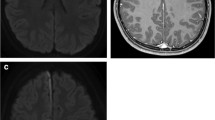Abstract
Background
Resection within the supplementary motor area (SMA) may be accompanied by dramatic motor deficits and speech arrest when the dominant hemisphere is involved, termed the SMA syndrome. Typically, the muscle tone of the paralyzed extremities is preserved, and in most cases, a complete or near complete recovery is seen within a few months. The SMA syndrome has not been recognized for extra-axial tumor surgery in approximation of the SMA.
Methods
We observed the SMA syndrome in a patient operated for a parasagittal meningioma in the posterior frontal region, and this observation intrigued us to prospectively collect similar cases.
Results
In the period from January 2010 to December 2015, we observed five patients who developed a partial SMA syndrome after surgery for frontal parasagittal meningiomas. The muscle tone was preserved in the affected extremities. All patients experienced improvement in motor function within a few days, and on follow-up, three out of five patients had recovered completely. Three of the patients had meningioma WHO grade II.
Conclusions
Surgically induced SMA syndrome can easily be confused with pyramidal weakness. This series of cases demonstrate that the syndrome may also develop after removal of extra-axial tumors and is probably underdiagnosed and underreported. The good functional prognosis is helpful in the preoperative counseling and follow-up of these patients.


Similar content being viewed by others
References
Abel TJ, Buckley RT, Morton RP, Gabikian P, Silbergeld DL (2015) Recurrent supplementary motor area syndrome following repeat brain tumor resection involving supplementary motor cortex. Neurosurgery 11(Suppl 3):447–456. https://doi.org/10.1227/NEU.0000000000000847
Acioly MA, Cunha AM, Parise M, Rodrigues E, Tovar-Moll F (2015) Recruitment of contralateral supplementary motor area in functional recovery following medial frontal lobe surgery: an fMRI case study. J Neurol Surg A Cent Eur Neurosurg 76:508–512. https://doi.org/10.1055/s-0035-1558408
Bannur U, Rajshekhar V (2000) Post operative supplementary motor area syndrome: clinical features and outcome. Br J Neurosurg 14:204–210
Carrieri G (1963) Syndrome of disturbance of the left motor supplementary area associated with a parasagittal meningioma. Riv Patol Nerv Ment 84:29–48
Fontaine D, Capelle L, Duffau H (2002) Somatotopy of the supplementary motor area: evidence from correlation of the extent of surgical resection with the clinical patterns of deficit. Neurosurgery 50:297–305
Goldberg G (1985) Supplementary motor area structure and function: review and hypotheses. Behav Brain Sci 8:567–588
Krainik A, Lehericy S, Duffau H, Capelle L, Chainay H, Cornu P, Cohen L, Boch AL, Mangin JF, Le Bihan D, Marsault C (2003) Postoperative speech disorder after medial frontal surgery: role of the supplementary motor area. Neurology 60:587–594
Louis DN, Ohgaki H, Wiestler OD, Cavenee WK (2007) World Health Organization histological classification of tumours of the central nervous system. International Agency for Research on Cancer, Lyon, WHO
Louis DN, Perry A, Reifenberger G, von Deimling A, Figarella-Branger D, Cavenee WK, Ohgaki H, Wiestler OD, Kleihues P, Ellison DW (2016) The 2016 World Health Organization classification of tumors of the central nervous system: a summary. Acta Neuropathol 131:803–820. https://doi.org/10.1007/s00401-016-1545-1
Penfield W, Roberts L (1959) Speech and brain-mechanisms. Princeton University Press, Princeton, N.J
Rostomily RC, Berger MS, Ojemann GA, Lettich E (1991) Postoperative deficits and functional recovery following removal of tumors involving the dominant hemisphere supplementary motor area. J Neurosurg 75:62–68. https://doi.org/10.3171/jns.1991.75.1.0062
Rousseau A, Mokhtari K, Duyckaerts C (2008) The 2007 WHO classification of tumors of the central nervous system—what has changed? Curr Opin Neurol 21:720–727. https://doi.org/10.1097/WCO.0b013e328312c3a7
Russell SM, Kelly PJ (2003) Incidence and clinical evolution of postoperative deficits after volumetric stereotactic resection of glial neoplasms involving the supplementary motor area. Neurosurgery 52:506–516
Sailor J, Meyerand ME, Moritz CH, Fine J, Nelson L, Badie B, Haughton VM (2003) Supplementary motor area activation in patients with frontal lobe tumors and arteriovenous malformations. Am J Neuroradiol 24:1837–1842
Schell G, Hodge CJ Jr, Cacayorin E (1986) Transient neurological deficit after therapeutic embolization of the arteries supplying the medial wall of the hemisphere, including the supplementary motor area. Neurosurgery 18:353–356
Tanji J, Shima K (1994) Role for supplementary motor area cells in planning several movements ahead. Nature 371:413–416. https://doi.org/10.1038/371413a0
Vergani F, Lacerda L, Martino J, Attems J, Morris C, Mitchell P, Thiebaut de Schotten M, Dell’Acqua F (2014) White matter connections of the supplementary motor area in humans. J Neurol Neurosurg Psychiatry 85:1377–1385. https://doi.org/10.1136/jnnp-2013-307492
Zentner J, Hufnagel A, Pechstein U, Wolf HK, Schramm J (1996) Functional results after resective procedures involving the supplementary motor area. J Neurosurg 85:542–549. https://doi.org/10.3171/jns.1996.85.4.0542
Author information
Authors and Affiliations
Corresponding author
Ethics declarations
Conflict of interest
The authors declare that they have no conflict of interest.
Ethical approval
All procedures performed in studies involving human participants were in accordance with the ethical standards of the institutional and/or national research committee and with the 1964 Helsinki declaration and its later amendments or comparable ethical standards. For this type of study, formal consent is not required.
Rights and permissions
About this article
Cite this article
Berg-Johnsen, J., Høgestøl, E.A. Supplementary motor area syndrome after surgery for parasagittal meningiomas. Acta Neurochir 160, 583–587 (2018). https://doi.org/10.1007/s00701-018-3474-3
Received:
Accepted:
Published:
Issue Date:
DOI: https://doi.org/10.1007/s00701-018-3474-3




